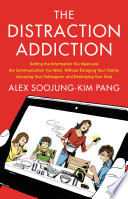

In 'The Distraction Addiction', the author, Alex Soojung-Kim Pang, delves into the nature of digital distraction, emphasizing how the constant barrage of notifications, social media, and digital content impacts our ability to focus. The book outlines the mechanisms through which technology can hijack our attention, leading to a fragmented cognitive state that hampers productivity and deep thinking. Pang argues that digital distractions are not merely nuisances; they are systemic issues that affect our work and personal lives. He provides insights into how the brain processes information and how the design of digital platforms often prioritizes engagement over meaningful interaction. By understanding these dynamics, readers can begin to recognize their own patterns of distraction and take steps to reclaim their attention.
Continue readingPang introduces the concept of 'deep work', which refers to the ability to focus without distraction on cognitively demanding tasks. He contrasts this with 'shallow work', which is non-cognitively demanding and often performed while distracted. The book highlights the value of deep work in achieving high levels of productivity and creativity. Pang argues that in an age of constant distractions, cultivating the ability to engage in deep work is more important than ever. He provides practical strategies for fostering deep work habits, such as setting aside dedicated time for focused tasks, creating distraction-free environments, and utilizing techniques like time blocking. By prioritizing deep work, individuals can enhance their performance and satisfaction in both professional and personal endeavors.
Continue readingOne of the key ideas in 'The Distraction Addiction' is the role of mindfulness in managing technology use. Pang advocates for a mindful approach to digital consumption, encouraging readers to reflect on their habits and the impact of technology on their lives. He suggests that mindfulness practices, such as meditation and self-reflection, can help individuals develop greater awareness of their attention and how it is influenced by digital devices. This awareness allows for more intentional technology use, enabling individuals to make conscious choices about when and how to engage with digital content. By incorporating mindfulness into their daily routines, readers can reduce the negative effects of distraction and cultivate a healthier relationship with technology.
Continue readingPang emphasizes the importance of designing a digital environment that supports productivity and focus. He discusses the various tools and applications available that can help individuals manage their time and attention more effectively. This includes using apps that block distracting websites, setting up notification filters, and organizing digital workspaces to minimize clutter. Pang also highlights the significance of establishing boundaries around technology use, such as designated times for checking emails or social media. By creating a productive digital environment, individuals can enhance their ability to concentrate and engage in meaningful work without being constantly pulled away by distractions.
Continue readingIn 'The Distraction Addiction', Pang also explores the role of community and collaboration in combating distraction. He argues that social support can significantly enhance our ability to focus and engage in deep work. By surrounding ourselves with like-minded individuals who value concentration and productivity, we can create an environment that encourages focus and accountability. Pang suggests that engaging in collaborative projects or joining communities that prioritize deep work can help individuals stay committed to their goals and reduce the temptation to succumb to distractions. This sense of community can foster a culture of focus, making it easier for individuals to resist the pull of digital distractions.
Continue readingA central theme in the book is the idea of reclaiming time and attention from the clutches of digital distractions. Pang provides readers with actionable strategies for taking back control over their time, such as setting clear goals, prioritizing tasks, and scheduling regular breaks to recharge. He emphasizes the importance of understanding one's own attention patterns and energy levels, encouraging readers to align their work with their natural rhythms. By reclaiming time and attention, individuals can create a more balanced and fulfilling life, where technology serves as a tool for enhancement rather than a source of distraction.
Continue readingFinally, Pang discusses the implications of distraction for the future of work. He highlights the growing importance of attention management skills in an increasingly digital world, where the ability to focus will be a key differentiator in the job market. As automation and artificial intelligence reshape the workforce, the demand for creative and critical thinking skills will rise, making deep work even more valuable. Pang encourages readers to view attention management as a crucial competency for future success, urging them to invest in developing their focus and productivity skills. By preparing for a future where distraction is prevalent, individuals can position themselves for success in their careers.
Continue reading